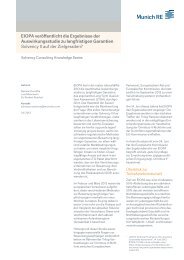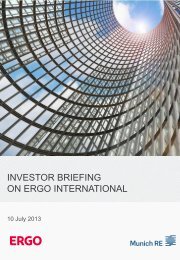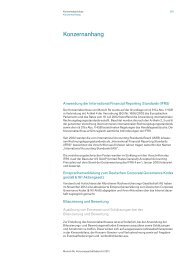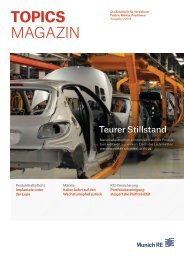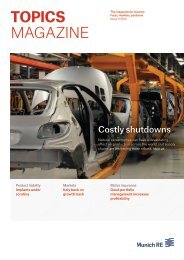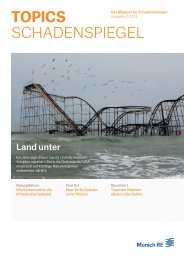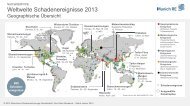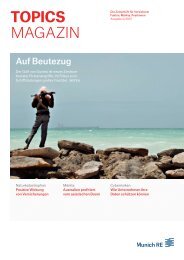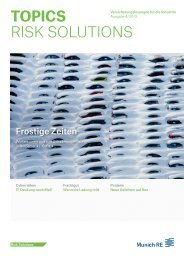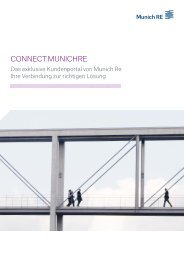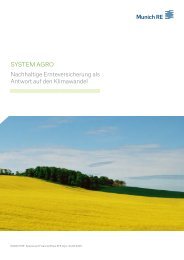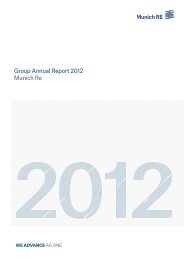Munich Re Group Annual Report 2006 (PDF, 1.8
Munich Re Group Annual Report 2006 (PDF, 1.8
Munich Re Group Annual Report 2006 (PDF, 1.8
Create successful ePaper yourself
Turn your PDF publications into a flip-book with our unique Google optimized e-Paper software.
<strong>Munich</strong> <strong>Re</strong> <strong>Group</strong> <strong>Annual</strong> <strong>Re</strong>port <strong>2006</strong><br />
ratio of 100% means that premium income was exactly sufficient<br />
to cover claims and costs. Net expenses for claims<br />
and benefits mainly include paid claims, the change in<br />
claims provisions, and the bulk of other underwriting<br />
expenses. The portion of other underwriting expenses not<br />
considered includes, for example, German fire brigade tax.<br />
Net operating expenses chiefly comprise the costs arising<br />
in the acquisition of new business (e.g. commission) and<br />
for the ongoing administration of insurance contracts.<br />
In the property-casualty reinsurance segment, there<br />
were net expenses for claims and benefits of €8,925m<br />
(11,329m) and net operating expenses of €3,846m (3,827m)<br />
in <strong>2006</strong>, compared with net earned premiums of €13,795m<br />
(13,565m). The combined ratio thus amounts to 92.6%<br />
(111.7%), an excellent figure, significantly due to the fact<br />
that we were largely spared major losses from natural<br />
catastrophes last year.<br />
The combined ratio in the health reinsurance segment<br />
amounts to 96.3% (93.0%), with net expenses for claims<br />
and benefits of €748m (658m) and net operating expenses<br />
of €303m (324m) comparing with net earned premiums of<br />
€1,091m (1,056m).<br />
The combined ratio in primary insurance is determined<br />
solely for the property-casualty segment (including legal<br />
expenses insurance), as most of the health primary insurance<br />
business is conducted like life insurance. In <strong>2006</strong>,<br />
paid claims and the change in claims provisions totalled<br />
€2,218m (2,338m) and net operating expenses €1,390m<br />
(1,390m), compared with net earned premiums of €3,975m<br />
(4,005m). Our combined ratio in primary insurance thus<br />
amounts to 90.8% (93.1%), an outstanding figure both in<br />
absolute terms and in comparison with competitors.<br />
When it comes to interpreting the combined ratio, the<br />
particular circumstances of the class of business in question<br />
have to be taken into account. The composition of the<br />
portfolio, for example, is of great significance. The following<br />
factors (among others) are important:<br />
– The more the claims burden fluctuates over time, the<br />
greater the risk is, and so the premiums needed to cover<br />
the risk must be higher. Loss ratios in good years, as well<br />
54<br />
Management report_<strong>Munich</strong> <strong>Re</strong> <strong>Group</strong><br />
as average loss ratios, have to be all the lower to provide<br />
the reinsurer with an adequate return for assuming this<br />
risk. This is particularly true in the case of natural catastrophes,<br />
which may occur rarely, but are often very<br />
severe when they do.<br />
– Another important distinguishing feature relates to the<br />
time-lag between premium being received and claims<br />
being paid. The longer these periods are, the longer the<br />
premiums received can be invested in the capital markets.<br />
High combined ratios in classes of business in which<br />
claims settlement takes a long time (e.g. casualty) therefore<br />
generally entail higher returns from investments<br />
with which the loss reserves are covered. These returns<br />
are not reflected in the combined ratio.<br />
Therefore, while we aim to keep our combined ratio as low<br />
as possible, it is not our only target.<br />
Rather, the key factor we consider is economic value<br />
added, which cannot be properly reflected by the combined<br />
ratio. We pursue this target internally through the<br />
performance metrics of value added and European Embedded<br />
Value (see page 52 f.), both of which are more meaningful<br />
and better tailored to the characteristics of the relevant<br />
business segments. Their common feature is that they<br />
measure value creation not only on the basis of current<br />
and forecast profits but also taking into account the size of<br />
the risks taken. Thus, when considering <strong>Group</strong> performance,<br />
we gear targets (by way of a common, linking element)<br />
to a risk-adjusted return. Although this is not a direct<br />
performance measure, it is a strong indication of the<br />
<strong>Group</strong>’s value creation.<br />
Risk-based <strong>Group</strong> return target for the financial year 2007<br />
We have set ourselves ambitious targets again for 2007, to<br />
follow up the successful performance of the past financial<br />
year. For this purpose, we are employing a risk-based performance<br />
measure which we used for external communication<br />
for the first time in <strong>2006</strong>: return on risk-adjusted capital<br />
(RORAC). We derive this target by placing the profit<br />
achieved or aimed at, expressed in euros, in relation to the<br />
necessary risk capital, the amount of which we determine



